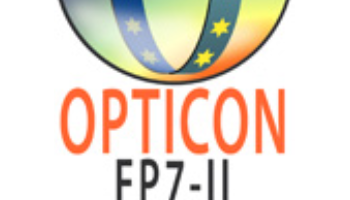
The R&D group is strongly involved in the OPTICON-H2020 program. We are working on 5 work packages on the following aspects :
– Developments in adaptive optics towards the E-ELT
– Enabling freeform active mirrors
– Enabling 3D printed smart structures and mirrors
– Innovative detectors
-
Towards adaptive optics for the E-ELT
Adaptive optics (AO) systems, using both natural and laser guide stars, are the key technologies for the next major advances in ground-based optical-IR astronomy in the next 20 years. The primary goal of workpackage 1 is to develop the technologies and the knowledge required to improve the performance and operational efficiency of existing AO facilities in Europe, as well as to develop the state of the art instrumentation required for the next generation of European astronomical facilities, i.e. the 40m European Extremely Large Telescope (E-ELT).
The significant progress made over the past 10 years in the field of AO has brought this observational technique to the maturity level where outstanding astronomical results can be obtained routinely. Astronomers are now looking toward the next generation of AO systems, which will allow them to extend this powerful technique to new observing modes (e.g. large field AO-assisted cameras and multi-object spectrographs to study the large scale structures of the Universe together with very high contrast imaging, spectroscopy and polarimetry to search for and characterize extra-solar planets, etc.).
Such ambitious scientific objectives will clearly increase the system complexity of future instruments, which in turn will require further development of critical technologies e.g. higher order deformable mirrors, faster real-time computers, Laser Guide Star wavefront techniques to cope with ELT specific challenges, better calibration/on-line control techniques and more efficient operation. Simulations, laboratory and on-sky demonstrations will be a significant part of the work plan of this WP, with the aim of implementing these new concepts and technologies on existing European facilities : VLT, WHT etc The work programme explores both new technology avenues where promising and builds on recognised FP6/FP7 technology highlights and successes.
-
Freeform Active Mirrors Experiment (FAME)
FAME is a four years effort which aims at providing a breakthrough component for future compact, wide field, high resolution imagers or spectrographs, based on the freeform technology and the flexibility and versatility of active systems.
The aim of the FAME effort is to combine extreme freeforms and deformable mirrors in order to propose an integrated solution to be used on future instrumentation, in warm or cooled environment. The work done so far already identified several compact, fast, wide field optical designs working in the visible, with a diffraction limited performance.
Using extremely aspheric mirrors (Freeform Mirrors) instead of more conventionally shaped optics in spectrographs can significantly reduce the number of optical components required. This reduction facilitates :
a. Reduction of the loss of the flux transmitted.
b. The possibility of wider fields of view.
c. Larger spectral bandwidths.
d. Easier access to UV band (fewer optics, only reflective).
e. Reduced mechanical integration complexity.
f. A reduction of the overall instrument mass and volume envelope.
g. Increased reliability and operational availability.
h. Reduction of optical component cost.We aim to demonstrate that by the end of 2016 it could be possible to adopt this technology in the designs of the proposed multi-object ELT instruments. To date the broad introduction of freeform optics has been inhibited because :
a. Tools for designing and analysing optical systems are not suited for free form components.
b. Production methods and metrology to create an accurate shape with high surface smoothness do not fit the requirements for optical/Infrared instruments. -
Advanced DMD-based Holographic Techniques
The use of Digital Micro-mirror Devices (DMD) in hologram recording is a well known practice in the anti-counterfeit precaution industry. They make it possible to obtain holograms with very complex characteristics. The photochromic HOE studied in WP 6.5 and particularly the CGH obtained in our earlier contract are limited in their application by the relatively simple figures that can be inserted in the hologram due to the standard holographic techniques in use. This WP is designed to work as follows :
DMD-based Holography in Astronomy : study to what extent DMD holography can be ported into fields of interest for the astronomical instrumentation such as the measuring and characterization of complex-form optics via CGHs.
DMD-based CGH writing device : Design and realize a laboratory level prototype of a CGH writing facility based on DMD, followed by the production of CGH samples and their characterization.




